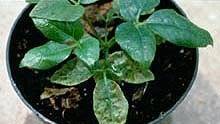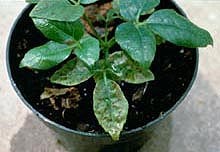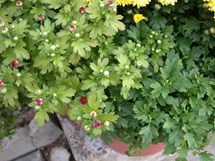Ammonium Toxicity


Most fertilizers contain one or more of the following forms of nitrogen: nitrate, ammonium or urea. Each form of nitrogen influences plant growth differently and the plant uptake significantly impacts the pH of the growing medium. Fertilizers with a high ratio of nitrate nitrogen will increase the pH of the growing medium as the plant uses the fertilizer. They can also partially reduce stem stretching, reduce excessive leaf expansion and create firmer plant growth. Fertilizers with a high ratio of ammonium and/or urea may decrease the pH of the growing medium after the acid produced by the roots neutralizes water alkalinity and limestone in the growing medium. High ammonium fertilizers can produce softer growth, greater leaf expansion, and induce minor stem stretching.
Causes of Ammonium Toxicity
As plants take up nutrients, they are deposited in the cells of leaves before being used by the plant. However, if plant nutrients are not used right away, they can start accumulating in these cells. Nitrate can safely be stored at high levels in plant cells, however, ammonium accumulation can damage plant cells.
Ammonium toxicity occurs when there is too much ammonium available for plant uptake from the growing medium. Typically this is not a problem when the growing medium is warm as nitrifying bacteria, naturally found in growing media, will convert ammonium to nitrate. During the winter when the growing medium drops below 55-60°F (13-15.5°C), the activity of these bacteria greatly slows; thereby little ammonium is converted to nitrate. In addition, there is a toxic, intermediary form of nitrogen, called nitrite (NO2), which also starts to accumulate in the growing medium due to the slow conversion process. Nitrite likely contributes to ammonium toxicity in plants.
Other factors that slow the activity of nitrifying bacterium include low oxygen levels in the growing medium from slow dry-down and low growing medium pH. Crops that are most sensitive to ammonium toxicity include coleus, eggplant, pansy, pepper, salvia, tomato and zinnia.


Symptoms of Ammonium Toxicity
Symptoms start in the newest leaves as chlorosis between the veins or these leaves completely turn a yellow-green color. Over time, necrotic spots form within the chlorotic areas and symptoms can progress down to the middle of the plant. Leaf edges could curl upward or downward, root growth slows, and in some cases, root tips may die.
Correcting Ammonium Toxicity
First, switch to a fertilizer that provides little to no ammoniacal nitrogen (such as 15-0-15) or a calcium-magnesium fertilizer. Second, increase the temperatures in the greenhouse to warm up the growing medium so nitrifying bacteria can actively convert ammonium to nitrate. Last, avoid keeping the growing medium wet, which also slows the activity of nitrifying bacteria. Within 7-10 days after making these adjustments, there should be no further progression of ammonium toxicity symptoms.
Preventing Future Ammonium Toxicity
As stated, ammonium toxicity is most likely to occur during the cold growing conditions of winter. From November through mid-March it would be advisable to adjust the following to minimize ammonium toxicity:
- Use fertilizers with a combined percentage of ammonium and urea of less than 40%.
- If possible, avoid applying high rates of fertilizer, which further reduces the amount of ammonium applied.
- Periodically test growing medium pH as low ammonium fertilizers are not as acidic, so growing medium pH could rise.
- Keep the pH of the growing medium at the upper end of the normal range for the crop grown (typically from 6.0-6.5).
- Make sure the growing medium temperature exceeds 60°F (15.5°C) to encourage the conversion of ammonium to nitrate, support active root growth and aid in the dry-down of the growing medium.
- Reduce the watering frequency and increase airflow to move stagnant humid air from the plant canopy.
References:
Mattson, N. 2013. Ammonium Toxicity: Avoid Getting Burned This Winter. GrowerTalks Vol. 77(10):36 https://www.growertalks.com/Article/?articleid=18726